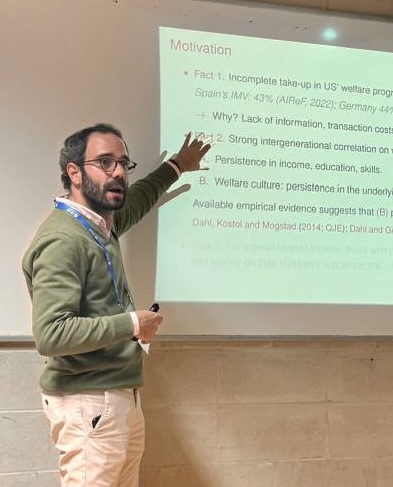I'm a quantitative macroeconomist with research interests in the fields of intergenerational mobility, income/wealth inequality, family economics, and aggregate productivity.
Publications
Aggregate effects of firing costs with endogenous firm productivity growth.
Macroeconomic Dynamics, Volume 27, Issue 4, June 2023, 945–965.
Abstract
Working paper
Slides
Codes
Published article
This paper quantifies the aggregate effects of firing costs in a model of firm dynamics where firm-level productivity is determined by innovation. In the model, the productivity distribution is endogenous, and thus, potentially affected by policy changes, allowing the model to capture both the static (allocative efficiency) and dynamic effects (changes in the distribution of firms' productivity) of firing costs. The model is calibrated to match key features of firms' hiring and firing behavior using firm-level data from Spanish non-financial firms. I show that firing costs equivalent to 2.5 monthly wages produce a 4% loss in aggregate productivity relative to the frictionless economy. The aggregate productivity losses rise to more than 10% when firing costs are equivalent to one year's wage. I show that a model with a standard AR(1) productivity process can only generate between 45 and 50% of these productivity losses. Overall, the results suggest that ignoring the effects of frictions on the dynamics of firms' productivity can substantially underestimate their aggregate effects.
Flattening of the Phillips curve with state-dependent prices and wages.
w/
James Costain and
Anton Nakov.
The Economic Journal, Volume 132, No. 642, February 2022, 546-581.
Abstract
Working paper
Slides
Codes
Published article
We study monetary transmission in a model of state-dependent prices and wages based on "control costs". Stickiness arises because precise choice is costly: decision-makers tolerate errors both in the timing of adjustments, and in the new level at which the price or wage is set. The model is calibrated to microdata on the size and frequency of price and wage changes. In our simulations, money shocks have less persistent real effects than in the Calvo framework; nonetheless, the model exhibits a substantial degree of non-neutrality, driven mainly by wage rigidity. State-dependent nominal stickiness implies a flatter Phillips curve as trend inflation declines, because price and wage adjustments become less frequent, making short-run inflation less reactive to shocks. Our model can explain almost half of the observed decline in the slope of the Phillips curve since 2000.
Working papers & work in progress
Intergenerational persistence in welfare program participation.
w/
Javier López Segovia.
Abstract
Working paper
Slides
Codes
Participation in social insurance (welfare) programs exhibits a significant persistence across generations. Children of welfare program participants are more likely to participate in these programs when they become adults, even after controlling for their income. This suggests some persistence in the underlying factors that affect the participation decisions of eligible households. To understand the source of this persistence and its implications on households and their children, we build a quantitative model with overlapping generations, heterogeneous agents, incomplete markets and child skill formation. In the model, participating in welfare programs entails a utility cost that that id correlated across generations. the model assumes paternalistic preferences, which makes parents with high participation cost to suffer a utility loss in case their children decide to participare. We calibrate the model to US datanad use our calibrated model to study the implications of welfare culture. We find that persistence in preferences towards welfare participation explains around 40% of the intergenerational persistence in welfare participation and 10% of the intergenerational persistence of skills.
Size-dependent regulations in Spain.
w/
Miguel Almunia,
Juan F. Jimeno and
David López-Rodriguez.
Abstract
Working paper
Slides
Codes
This paper studies the interaction effects of multiple size-dependent regulations. Using administrative data for Spanish businesses in the period 2014-19, we investigate the impact of more stringent labor regulations imposed on firms with over 50 employees and of stricter tax monitoring on firms with annual operating revenue exceeding €6 million. We find that firms bunch below each of these cutoffs, especially those that are also subject to the other regulation, suggesting an interaction effect between the two policies. We specify a model of firm dynamics that replicates the patterns observed in the data and we use the model to quantify the aggregate effects of alternative policies that either eliminate each regulation or generalize them to all firms. We find that regulations lead to lower aggregate output and increase the relative weight of small firms in terms of employment and revenues. However, regulations have a positive effect on aggregate TFP compared to an economy without regulations where firms can misreport their revenues. This is because the possibility of misreporting creates a tax wedge, pushing firms' input demand above the optimum level.
Intergenerational effects of child-related tax benefits in the US.
Abstract
Working paper
Slides
Codes
The presence of children in US households reduces tax liabilities through deductions and tax credits. Through the lens of the quantity-quality trade-off, these benefits distort parental choices over the number and human capital of children by altering their relative implicit price. This paper quantifies the effects of child-related tax benefits on fertility and intergenerational mobility using a general equilibrium life-cycle model with endogenous fertility choices and parental investments in children's human capital, calibrated to US data. I show that tax benefits increase fertility by 16%, but they do so at the expense of lowering human capital of children. More importantly, these effects are particularly strong among low educated mothers, which widens the gap in human capital between children of low and high educated mothers. As a result, the intergenerational persistence of education increases by 37% when tax benefits are introduced. I also show that education subsidies are also effective at fostering fertility but, as opposed to tax benefits, they do not decrease children's human capital, nor intergenerational mobility.



